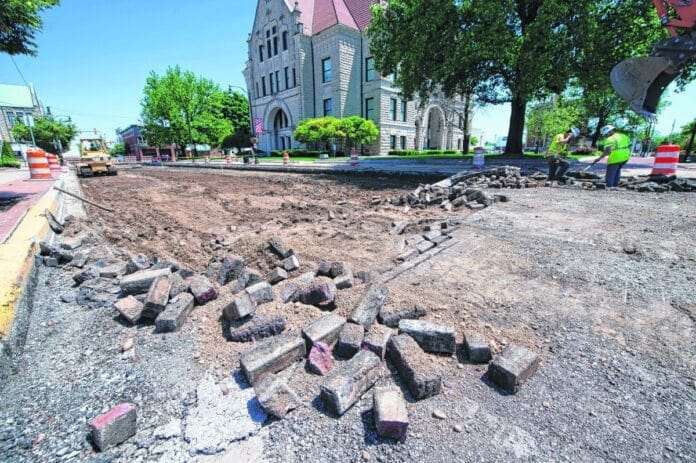
GREENFIELD — Long before downtown State Street was made up of asphalt, the thoroughfare was paved in bricks.
Those blocks have remained where they are ever since they were first laid more than a century ago. They’ve resurfaced during the demolition of the street as the state’s reconstruction of State Road 9, known as State Street through town, continues. Rather than cover the bricks back up, many in front of Greenfield City Hall were removed to be used in ways that will allow them to see the light of day once more.
Many of the bricks are stamped with “Buckeye Block,” referring to the former Roseville Brick and Terra Cotta Company in Roseville, Ohio. The company was in business from 1891 to 1908, according to the Roseville Historical Society.
In 1898, when Greenfield’s population was around 4,500, The Hancock Democrat reported that contractor C.M. Kirkpatrick got the job to brick Main, State and East streets.
According to a history compiled by G. Edward Knight of Knightstown, Christian M. “Kit” Kirkpatrick lived in Greenfield, and his company built the Interurban railroad from the city to Indianapolis and elsewhere throughout the state.
Joan Fitzwater, Greenfield planning director, said so far the city has managed to set aside three dump truck loads of the historical bricks that formerly made up State Street in front of City Hall. She said they’ll possibly be used to repair Depot Street, which is made of brick, or be used on trails or in parks to preserve a unique part of the city’s past.
“They’re not making any more of these,” Fitzwater said. “It’s just another piece of our heritage, and a reminder of how we came to be who we are today. “The National Road (Main Street/U.S. 40) and State Road 9 are important transportation routes that put Greenfield on the map.”
Brigette Jones, former president of the Hancock County Historical Society and current executive director of the Hancock County Tourism Commission, said before bricks, roads through town were lined with planks that would clatter as horses trotted along. Pothole-prone Macadam streets replaced those, which were dusty when dry and mucky when wet.
“They’re heavy,” Jones said of the Buckeye Blocks. “They’re not just like bricks you put on a house. They’re paving bricks, like what you’d find under the Indianapolis Motor Speedway.”
It quickly became the material of choice.
“Main streets would’ve been bricked first, and then side streets would’ve been bricked later,” Jones said. “So there’s a lot of brick under a lot of our streets.”
At the time the bricks were going in downtown, Indiana was in the midst of its gas boom following the discovery of the Trenton Gas Field in the east-central part of the state and part of Ohio in the 1880s.
“The time period would’ve been a time of extreme growth,” Jones said. “A lot of our buildings that you see that are downtown were built right around this time period.”
That includes the Hancock County Courthouse; the H.B. Thayer building on State Street’s east side north of Main Street; the L.C. Thayer building at the northwest corner of Main and East streets; and the former Masonic building that houses Bradley Hall at the northwest corner of State and Main streets.
“Greenfield would’ve been a happening place because of the gas boom and the buildings being built,” Jones said.
Joe Skvarenina, Hancock County historian, agreed.
“All the services were here in town, all that you needed,” he said.
As Knight’s history reported, it was also a time when the Interurban railway was being developed in Hancock County and throughout the state. But it didn’t last long, as a new form of transportation was picking up speed.
“Indiana had one of the best and most extensive mass transit systems in the world,” Jones said. “And when the automobile became popular, it killed it. … You could hop on the Interurban and go from Mohawk all the way up to Maxwell and then take it up to Willow Branch and go all the way to New Castle. It connected a lot of our little communities. Of course, when that went away, it hurt a lot of our communities.”
Along with Depot Street, a brick alley remains at surface level in town running to the west of The Garden Chapel at 226 W. North St.
Skvarenina applauds city’s efforts to save the bricks.
“They’re characteristics of an era gone by in Greenfield,” he said.




